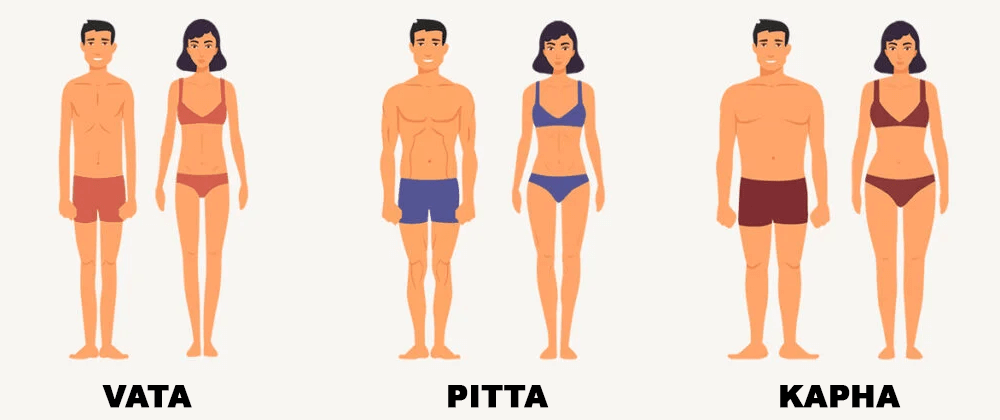In this post, we’ll unpack all you need to know about Doshas, defining exactly what they are, the different types, how they impact our health and well-being and more.
What Are Doshas?
Doshas stem from the Ancient holistic health system of Ayurveda and refer to the specific energies that are present within us which influence our mental, emotional, physical and spiritual well-being.
The Doshas arise from the 5 elements of nature — space (akash), air (vayu), fire (tejas), water (jala) and earth (prithvi).
The 3 Doshas
According to Ayurveda, there are three primary Doshas. They are: Vata, Pitta and Kapha.
While all three Doshas are present within us, one or two tend to dominate. The dominant Doshas then become our own personal blueprint for perfect health. In rare cases, there is a more or less equal blend of all three Doshas which is referred to as Tridoshic.
The combination of Doshas we are born with is referred to as prakriti. Our state of balance at any given time is referred to as vikriti.
Our dosha determines out constitution which influences our physiology, our likes and dislikes, our tendencies and habits, our mental and emotional character and our vulnerabilities toward imbalance and disease.
Below is a summary of the characteristics associated with each Dosha.
Vata
- Elements: Air & Ether
- Energy: Rajasic
- Represents: Movement
- Quality: Catabolic, Activating & Dynamic
- Season: Autumn
- Mind: Creative
- Body: Lean
- Challenge: Sticking to one idea.
- Imbalance: Anxiety & Digestion
Pitta
- Elements: Fire & Water
- Energy: Satvic
- Represents: Digestion
- Quality: Metabolism, Balancing & Transformative
- Season: Autumn
- Mind: Ambitious
- Body: Athletic
- Challenge: Burnout
- Imbalance: Anger & Heartburn
Kapha
- Elements: Earth & Water
- Energy: Tamasic
- Represents: Structure
- Quality: Anabolic, Conserving & Stabilising
- Season: Spring
- Mind: Peaceful
- Body: Rounded
- Challenge: Selflessness
- Imbalance: Sadness & Weight

The Key To Health & Well-Being
In Ayurveda, balance is everything — and balance is achieved by harmonizing the 3 Doshas. Each dosha has a specific impact on our mind, emotion, body and spirit.
When the three Doshas are in balance, it results in health and ease in the body. When the 3 Doshas are out of balance, it results in sickness and dis-ease in the body.
By identifying our predominant Doshas, we can take steps to create habits that harmonise our Doshas and optimise our mental, emotional, physical and spiritual health and well-being.
Below we’ll unpack each of the 3 Doshas in more detail.
Vata Dosha
Vata translates literally from Sanskrit to “wind.” It is made up of the elements of air and ether and represents movement. It is is associated with the season of Autumn. People with a Vata Dosha tend to have a creative mind and lean body.
The Functions Of Vata
- Creates energy
- Helps eliminate excretions
- Creates dryness
- Activates mind and speech mechanisms
- Controls inspiration
- Stimulates action
- Controls endocrine gland functions
- Balances the tissues
The Locations of Vata
- Feet
- Bone Marrow
- Skin
- Nervous System
- Thighs
- Bladder
- Colon
- Lumbar
Recommended Foods For Vata
Vatas are naturally cold, dry, mobile and rough in energy so they need foods that are more warm, moist, dense and oily in energy to create balance. Below we’ll unpack what foods are recommended for people with a predominant Vata Dosha.
Fruits
- Apples (cooked)
- Apricots (fresh)
- Avocados
- Bananas (ripe)
- Berries
- Melons
- Cherries
- Coconuts
- Dates
- Figs
- Grapefruit
- Grapes
- Kiwifruits
- Lemons
- Limes
- Mangoes
- Oranges
- Papayas
- Peaches
- Pineapples
- Plums
- Watermelon
Vegetables
- Asparagus
- Beets
- Carrots (soaked)
- Chiles
- Cilantro
- Cucumbers
- Garlic
- Green beans
- Leeks
- Mustard greens
- Okra
- Olives (black)
- Onions (cooked)
- Parsnips
- Peas (cooked)
- Pumpkin
- Spinach (cooked)
- Squash
- Sweet potatoes
- Watercress
- Zucchini
Grains
- Amaranth
- Basmati Rice
- Brown Rice
- Oats (cooked)
- Quinoa
- Wild Rice
Legumes
- Mung Beans
- Tofu
Nuts & Seeds
- Any that are raw
Oils
- Almond Oil
- Extra Virgin Olive Oil
- Mustard Oil
- Sesame Oil
Sweeteners
- Coconut sugar
- Date sugar
- Honey
- Maple syrup
- Stevia
Spices
- Basil
- Black Pepper
- Cardamom
- Cinnamon
- Cloves
- Coriander
- Cumin
- Fennel
- Finger
- Mustard Seeds
- Nutmeg
- Paprika
- Rosemary
- Saffron
- Turmeric
Pitta Dosha
Pitta translates literally from Sanskrit to “heat.” It is made up of the elements of fire and water and represents digestion. It is associated with the season of Summer. People with a Pitta Dosha tend to have an ambitious mind and athletic body.
The Functions Of Pitta
- Sight
- Digestion
- Heat
- Contentment
- Appetite
- Chivalry
- Softness
- Anger
- Pleasantness
The Locations of Pitta
- Eyes
- Heart
- Blood
- Spleen
- Liver
- Skin
- Sweet Glands
- Digestive Tract
Recommended Foods For Pitta
Pittas are naturally hot, oily, sharp and pungent in energy so they need foods that are more cool, juicy, sweet and dry in energy to create balance. Below we’ll unpack what foods are recommended for people with a predominant pitta Dosha.
Fruits
- Apples (sweet)
- Apricots (sweet)
- Avocados
- Bananas (sweet)
- Berries (sweet)
- Cherries (sweet)
- Coconuts
- Dates
- Figs
- Grapefruit
- Grapes (sweet)
- Mangoes (ripe)
- Melons
- Oranges (sweet)
- Papayas
- Pears
- Pineapples (sweet)
- Plums (sweet)
- Pomegranates
- Strawberries
Vegetables
- Artichokes
- Asparagus
- Beets (cooked)
- Bell Peppers
- Broccoli
- Brussel Sprouts
- Cabbage
- Carrots (soaked)
- Cauliflower
- Celery
- Cucumbers
- Leafy Greens
- Spinach (raw)
- Squash
- Sweet potatoes
- Zucchini
Grains
- Amaranth
- Barley
- Basmati Rice
- Couscous
- Oats
- Quinoa
- Wild Rice
- White Rice
- Spelt
- Wheat
Legumes
- Black beans
- Chickpeas
- Lentils
- Mung Beans
- Split peas
- Tempeh
- Tofu
Nuts & Seeds
- Almonds (soaked and peeled)
- Chia seeds
- Flaxseeds
- Pumpkin seeds
- Sunflower seeds
Oils
Sweeteners
- Coconut sugar
- Date sugar
- Honey (raw)
- Maple syrup
- Stevia
Spices
- Basil (fresh)
- Black Pepper
- Cardamom
- Cinnamon
- Coriander
- Cumin
- Dill
- Fennel
- Ginger
- Mint
- Parsley
- Peppermint
- Saffron
- Turmeric
- Vanilla
Kapha Dosha
Kapha translates literally from Sanskrit to “‘phlegm.” It is made up of the elements of earth and water and represents structure. It is associated with the season of Spring. People with a Kapha Dosha tend to have a peaceful mind and round body.
The Functions Of Kapha
- Stickiness
- Forgiveness
- Potency
- Knowledge
- Lubrication
- Immunity
- Heaviness
- Unity
- Strength
The Locations of Kapha
- Head
- Joints
- Heart
- Chest
- Extremities
- Neck
- Stomach
- Tongue
Recommended Foods For Kapha
Kaphas are naturally dense, heavy, oily and sweet in energy so they need foods that are more light, dry, bitter and astringent in energy to create balance. Below we’ll unpack what foods are recommended for people with a predominant Kapha Dosha.
Fruits
- Apples
- Apricots (fresh)
- Berries
- Cranberries
- Lemons
- Limes
- Pears
- Pomegranates
Vegetables
- Artichokes
- Asparagus
- Beets
- Bell peppers
- Broccoli
- Brussel Sprouts
- Cabbage
- Carrots
- Cauliflower
- Celery
- Leafy Greens
- Peas
- Peppers
- Radishes
- Spinach
- Sprouts
- Turnips
Grains
- Amaranth
- Barley
- Buckwheat
Millet
- Quinoa
Legumes
- Black beans
- Chickpeas
- Lentils
- Mung beans
- Split Peas
- Tempeh
- Tofu
Nuts & Seeds
- Almonds (soaked and peeled)
- Chia seeds
- Flaxseeds
- Help seeds
- Pumpkin seeds
- Sunflower seeds
Oils
- Almond Oil
- Extra Virgin Olive Oil
- Flaxseed oil
- Ghee
Sweeteners
- Honey
- Stevia
Spices
- Basil
- Bay leaf
- Black Pepper
- Cardamom
- Cayenne
- Cinnamon
- Cloves
- Coriander
- Cumin
- Fennel
- Fenugreek
- Garlic
- Ginger
- Mint
- Mustard Seeds
- Nutmeg
- Oregano
- Paprika
- Rosemary
- Saffron
- Turmeric
Summary
Doshas are inherent energies that determine our body constitution. The three primary Doshas are Vata, Pitta and Kapha.
While all three Doshas are present in everyone, one or two usually dominate and become our own personal blueprint for perfect health
Identifying our predominant Doshas allows us to create habits that harmonise them and optimise our mental, emotional, physical and spiritual health and well-being.







